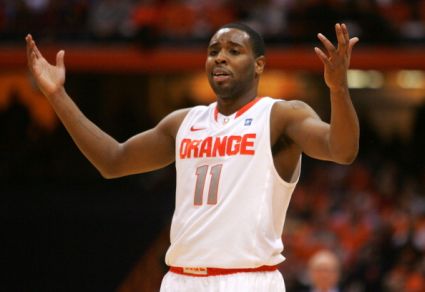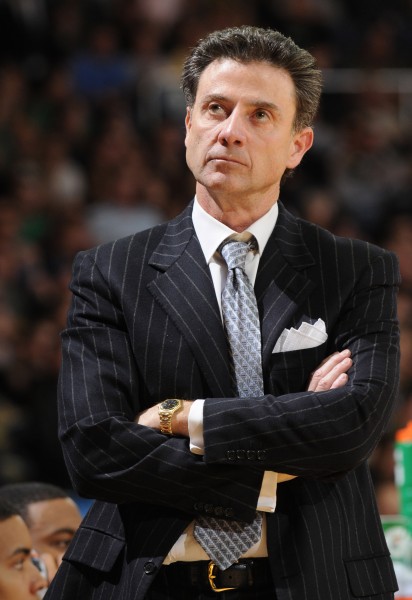What I Learned, Sweet Sixteen Edition: Part One
Posted by zhayes9 on March 19th, 2012Zach Hayes is an editor, contributor and bracketologist for Rush the Court, on loan from the editorial freelancers association.
The last four days I’ve successfully slipped into a hoops coma, watching every game from Murray State-Colorado State on Thursday afternoon to Cincinnati closing out Florida State to finalize this season’s Sweet 16. In between the thrilling last-second finishes, the shocking upsets and the blowout snooze-fests, stars were born and flaws were exposed. Starting with the East and West regions, here’s one prevailing lesson learned from each remaining team as I somehow try to survive without hoops until Thursday:
Syracuse: The matchup with Wisconsin is less than ideal. All season long, Syracuse has been an absolute menace in transition. Jim Boeheim teaches his guards to seek out steals and, prior to his suspension, Fab Melo’s shot-blocking prowess often acted as the first pass towards a layup on the other end. Without Melo’s services, the front line of Syracuse’s zone isn’t quite as aggressive, while fast break points will come at a minimum against a Bo Ryan-coached team who has finished in the top five in turnover percentage in each of the last four seasons. Forcing fewer turnovers coupled with an opponent who fumbles the ball once in a full moon is a discouraging combination. The Orange will be forced to leave their comfort zone and execute at a slower pace in the halfcourt to advance. Look for a heavy ball-screen attack with Dion Waiters and Scoop Jardine.
Wisconsin: They need a plan against a zone defense. Vanderbilt switched to a 2-3 zone with about three minutes to play on Saturday and Bo Ryan’s crew didn’t seem to have a clue, passing the ball around the perimeter before chucking a deep, contested three late in the shot clock. Wisconsin certainly has the gunners at every position to drain their fair share of shots from downtown, but if Wisconsin wants to avoid long rebounds and a plethora of transition points for the Orange the other way, they’ll need to expand their repertoire against the zone. Ryan Evans or Josh Gasser don’t exactly have a lot of experience operating in the middle of that type of defense. Bo Ryan will need to cook up an effective plan in the next three days.
Cincinnati: Jaquon Parker turned around their season. The simple narrative is that Cincinnati’s brawl with Xavier on December 10 acted as a galvanizing force that turned around a floundering season and catapulted the Bearcats to this point. The real reason for their turnaround is the emergence of Parker, a talented 6’3” sophomore guard whose return from injury allowed Cronin to employ four guards around Yancy Gates. Cincinnati’s three-point and isolation heavy offense suddenly became much more potent with another athletic ball-handler in the lineup capable of making defenses pay from deep, while Justin Jackson moved to a preferred role as an energizer bunny off the bench.
Ohio State: The Buckeyes don’t have one semi-reliable bench player. Thad Matta is known for only playing six or seven players by the time March rolls around, mostly by choice rather than necessity. Last year, Matta could at least rely on DeShaun Thomas’ instant scoring or Dallas Lauderdale’s post defense for a shot in the arm in case one of his starters needed a rest or succumbed to foul trouble. This year the pickings are slim: Sam Thompson is all raw athleticism, Evan Ravenel is lost offensively and defenses don’t even guard Shannon Scott. Ohio State survived a 13-minute stretch in the first half against Gonzaga with Jared Sullinger on the bench with two fouls largely due to an uncharacteristic offensive explosion from Aaron Craft. Can they depend on that type of effort again?
Michigan State: Keith Appling has to make jump shots. A casual observer never would have guessed Appling shot 41 percent from three as a freshman the way Rick Majerus instructed his team to defend him on Sunday. The Billikens sagging defense dared Appling to fire and he responded with two huge jump shots late in the Spartans’ grind-it-out win. Appling must make defenses respect his jumper in order for State to execute their plethora of halfcourt sets. A clogged lane disrupts movement and makes it easier for defenses to double Derrick Nix and Adreian Payne in the post. The Spartans face a 2-3 zone in Louisville, but it’s often a hybrid look that can switch to straight man at any moment during a possession.
Louisville: Rick Pitino is a future Hall-of-Famer for a reason. The common refrain was that 2011 was Pitino’s best coaching job at Louisville, somehow molding an unheralded unit into a Big East contender and number four seed. The laundry list of obstacles grew this season: three-point specialist Mike Marra tore his ACL, backup big Stephan Van Treese never saw the floor with a knee injury, five-star recruit Wayne Blackshear missed most of the year with a shoulder problem and Pitino had to massage the ego of point guard Peyton Siva, who struggled with confidence and a season-long shooting slump. Pitino masterfully drilled the principles of that matchup 2-3 zone into his players’ heads to the tune of the number two defensive efficiency in the country and he installed that chaotic full-court press just in time for a Big East Tournament championship.
Marquette: Buzz Williams has utilized Davante Gardner to perfection. The Golden Eagles truly discovered their identity late in the season as a run-and-gun, up-tempo unit hiding the fact that 6’7” Jamil Wilson was their tallest player on the floor. Gardner’s return from a knee injury could have easily disrupted their rhythm and flow, but Williams knew he couldn’t completely discard his most reliable post scorer. Williams played Gardner just 12 minutes against Murray State largely because the game was way too fast for his bulky sophomore, but the coach picked his spots well and Gardner delivered with six crucial points with the Golden Eagles on the ropes. Expect him to do the same against the girth of Florida’s Patric Young.
Florida: They’re more than just three-point shooters. Billy Donovan encourages his guards to take threes and they oblige. The Gators receive 38.4 percent of their points from beyond the arc, the highest percentage of any team remaining in the field. Still, the Gators proved over the weekend they don’t necessarily have to live and die by the three. Florida embarrassed Virginia despite making just four threes and followed that up by shooting 53 percent from the floor against Norfolk State. Brad Beal can certainly operate off the dribble and Young is a capable post scorer if he can carve out deep position. There’s more to this team than their reputation would indicate, although that misperception is largely a fault of their own.
Coming tomorrow: Midwest and South regions.












































